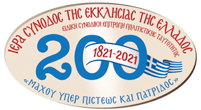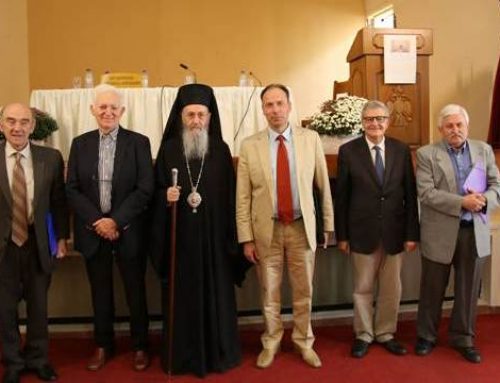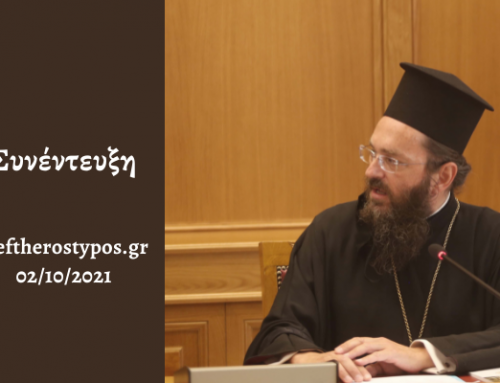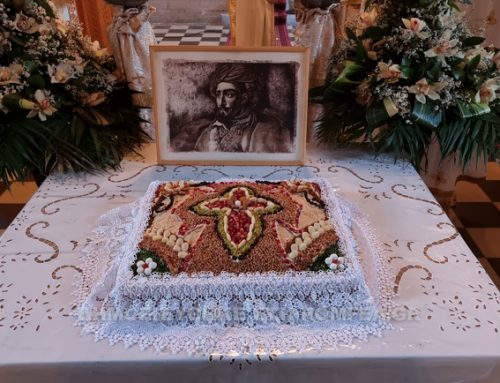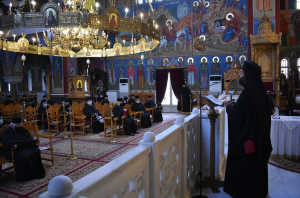
On Thursday, February 18, 2021, the occasion of the bicentenary of the outbreak of the Revolution of 1821, the Most Rev. Metropolitan Panteleimon of Maroneia and Komotini delivered a public lecture before the Clergy of the Holy Metropolitanate on the subject: “The contribution of the Holy Clergy of our Holy Metropolitanate to the Struggle of 1821”.
The Most Rev. Metropolitan commenced by referring to the Memoirs of Theodoros Kolokotronis, where the famous chieftain of the Revolution of 1821 explicitly acknowledges the primacy of the contribution of the clergy to it.
After mentioning examples of self-sacrifice such as Bishop Isaiah of Salona, Athanassios Diakos (Deacon), Papaflessas, the speaker focused on the part of Patriarch Gregorios V, who, “in his capacity of leader of the nation, was forced to draft an act of excommunication at the expense of the revolutionaries so as to avert slaughter and retribution on the part of the conquerors against the enslaved Hellenism. The manner in which the text of the excommunication was drafted ran counter to the Canonical Law of the Church. It was an act by the Martyr Patriarch aiming to appease the wrath of the Sultan and the Sublime Porte. This Shepherd attempted to preserve the equilibrium, with prudence and discretion and, after much praying, without caring about ‘impressions’ and despite the reactions by some, proceeded to the act of ‘moral self-sacrifice’ in question, as it was qualified by historians.
An indication of political far-sightedness on the part of Patriarch Gregorios V was his answer to the Metropolitan of Derkoi, who encouraged him to take refuge in the Peloponnese so as to be able to lead the Revolutionary Struggle there, under the pretext that they would go there to ‘bring the rebels back to reason’: “Holy Brother of Dercoi, we are old men and near the end of our lives and, if this happens, then we shall give the Sultan the excuse to slaughter all the Greeks. If we stay and get slaughtered ourselves, then we shall give time to Christianity to come to the rescue of the Greeks in the areas which have not rebelled”, which was what came to pass. The Patriarch was hanged outside the central gate of the Patriarchate to set a deterring example. The deterrence was never achieved but the martyr’s attitude demonstrated by Saint Gregorios V became an example worthy of imitation, an example of prudence and self-sacrifice, crowning him with the chaplet of the Holy National Martyr.
Our Thrace, and our Metropolitanate in particular, brought forth heroic clergymen, comparable to Bishop Ghermanos of Old Patras, Gregorios V, and Athanassios Diakos. A typical figure of a great clergyman and fighter of 1821 was, among many others, that of the late Metropolitan Constantios of Maroneia, great national raiser and enlightened Hierarch, whose statue has adorned the courtyard of the Holy Cathedral of our town since November of 1981”.
From this point on, drawing upon bibliographical sources, the Most Rev. Metropolitan made extensive reference to the life and work of Metropolitan Constantios (born ca. 1770-1780 in Mademohoria of Halkidiki – d. in November 1821), member of the “Society of Friends” and actively involved in the outbreak of the Revolution of 1821. “His part in the meetings of the leading fighters and representatives of the Holy Monasteries of Mount Athos was paramount and it was thanks to his assistance that the recruitment of 1,000 monks as fighters became possible”.
The speaker stated that, “following thorough research”, he was able to identify a hierodeacon by the name of Ioannikios, who later also became Metropolitan of Maroneia (1838-1839) and was known as “Ioannikios the Friendly” [from his active membership of the Society of Friends]. “His bones are kept today in the ossuary of the bishops of our town”.
The Most Rev. Metropolitan also highlighted the part played by other clergymen – fighters of 1821 from the other Holy Metropolitanates of Thrace, such as Metropolitan Dorotheos I of Adrianople (bishop from 1821 to 1821), who “studied in Paris, was initiated into the Society of Friends, and was hanged in Constantinople, as part of the retribution of the Ottomans for the outbreak of the Revolution in the Transdanubian Principalities, alongside the following bishops, who also died a martyr’s death: Metropolitan Gregorios of Derkoi, Bishop Eughenios of Anchialos, Metropolitan Iosseph of Messemvria, Bishop Neophytos of Myriophyton, and Bishop Gherassimos of Ganos and Hora.
Moreover, in Saranta Ekklissies, along with the headmen, Father Constantinos was hanged, while on the Sunday after Easter, April 17, 1821, in Adrianople, Father Theocles, Protosynkellos of the Holy Metropolitanate, and Archimandrite Iakovos Arzoumanides, Synkellos, were slaughtered. Another remarkable figure was that of Metropolitan Paissios of Sozopolis, who, in April of 1821, swore in ca. 5,000 fighters in the Holy Church of Saint Zossimos, was captured by the Ottomans, refused to abjure the Revolution, and was therefore hanged. The same sad fate was reserved for Father Hatziaslanis Antonakis Skouloglou in Anchialos, together with local headmen.
Finally, an important personality in the Struggle was also the predecessor of the Martyr Patriarch Gregorios V, Ecumenical Patriarch Kyrillos VI (1813-1818), who martyred on April 18, 1821, in Adrianople, by hanging. Like Gregorios V, Kyrillos VI was also proclaimed a Saint of our Church, while as of 1834 there is a special Service in his honour”.
Most Rev. Metropolitan Panteleimon concluded his lecture by reminding his clergymen of the advice of Patriarch Gregorios V to Bishop Isaiah of Salona: “Fight, for the fight is nigh, but beware, that your conduct be commensurate with the site you find yourselves in”.
+ METROPOLITAN P A N T E L E I M O N
OF MARONEIA AND KOMOTINI
